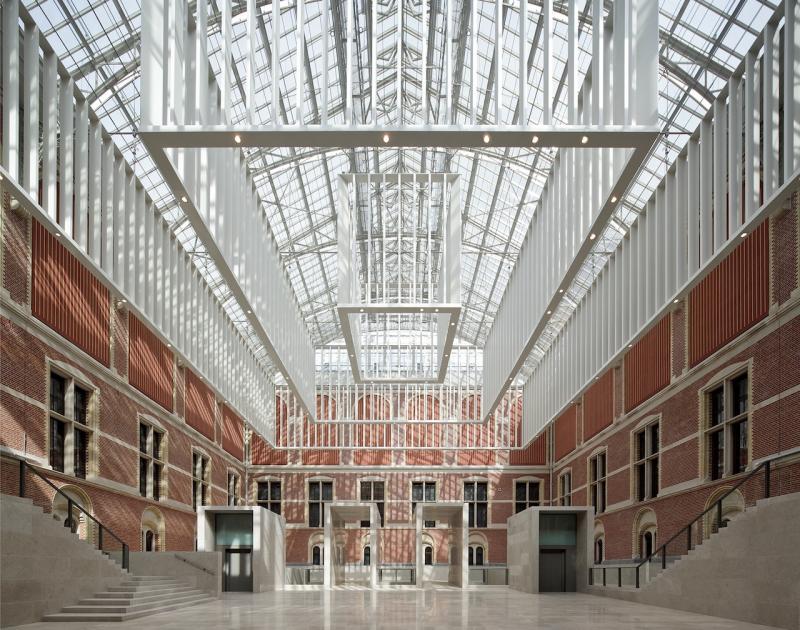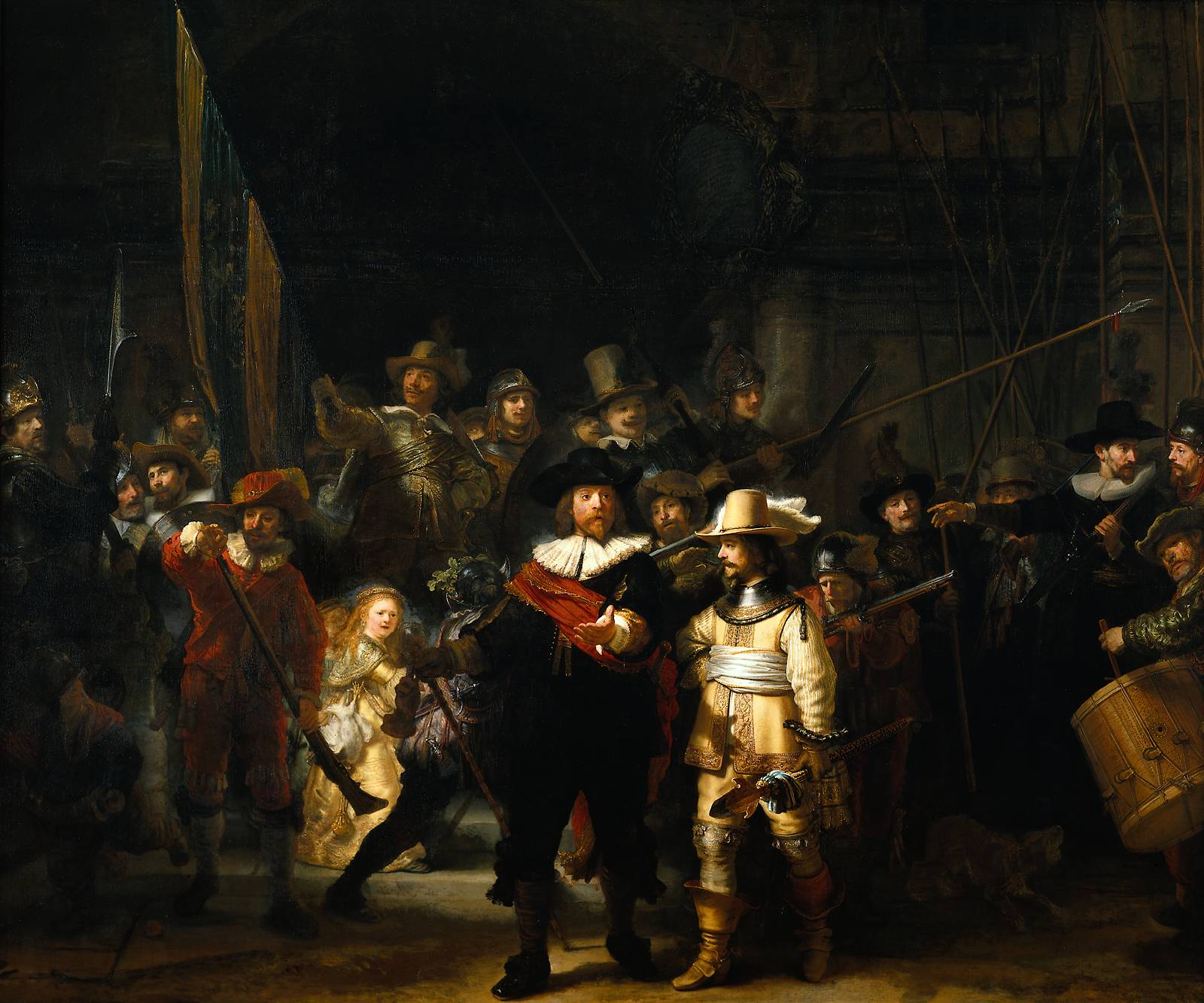theartsdesk in Amsterdam: Reopening of the Rijksmuseum | reviews, news & interviews
theartsdesk in Amsterdam: Reopening of the Rijksmuseum
theartsdesk in Amsterdam: Reopening of the Rijksmuseum
A very bold but beautifully sympathetic restoration for Holland's national museum

The Rijksmuseum is reopening after 10 years. What took it so long? Escalating costs, contractual problems, a protracted battle with the cycling lobby (this is Amsterdam, after all). I’m sure there’s more, but one whole decade’s worth? It’s a long time to go without a national museum that represents the best of Dutch art to the Dutch people, and to the world.
It’s easy to forget what a spectacular Medievalist fantasy the building actually is
But it’s all OK now. It’s been worth the wait. In fact, the improvement is staggering. The crepuscular gloom has been lifted and light has flooded in. You can, wow, actually see stuff. You can see and you can breathe. It feels like all the windows of a neglected, musty old stately home have been flung open and now the treasures within each room are lovingly illuminated. Hurrah.
At the heart of the building is the vast glass-ceilinged atrium: airy, bright and very modern. So it’s easy to forget what a spectacular Medievalist fantasy the building actually is, at least when you first step inside. It was designed in the 1880s by Pierre Cuypers, who also built Amsterdam Central Station. In the old days, you’d almost expect a train to come rushing through its central courtyard. But thankfully, this isn’t the wrecking Sixties, so a respect for the integrity of the original design has ensured that Cuypers’ Gothic decorative scheme has been retained by architects Cruz and Ortiz. The huge stained glass windows (pictured below) and the walls of the corridors that have been decorated with figures in Medieval garb emerge in all their spruced-up glory.

Except for a new “Hall of Honour”, where, organised by artist, you’ll find the great painters of the 17th-century Golden Age – Vermeer, Rembrandt, Steen, de Hooch, Ruisdael – the collection has been mixed up to great effect.
Sculpture sits easily with painting, and painting with the decorative and applied arts: furniture, ceramics, including the most elaborate Delftware you’ve ever seen, firing cannons, model sailing vessels, elaborate dolls houses of vast magnitude (not for children but for the amusement of wealthy ladies). There's a wooden box from the 17th century that looks like an ordinary humidor but with silver pouches for cuts of opium, and, on the top floor where the 20th century awaits you, a collaborationist Nazi chess set with pieces shaped like tanks, infantrymen and bomber planes. Next to the Mondrians and Van Doesburgs, you'll even find a 1917 Bantam airplane, built by aviation design pioneer Frits Koolhoven
It’s the chronology that matters, not classification. It’s history told through an amazing national collection. For instance, a wonderfully experimental, chiaroscuro self-portrait by Rembrandt aged 22, hangs in a room containing an ebony cabinet exquisitely inlaid with mother-of-pearl. It was made by celebrated cabinet-maker Herman Doomer, a friend to the artist who also made Rembrandt’s frames.
 Every bit of this is irresistible, though you can’t deny that the illustrious Hall of Honour – cheesily named, perhaps, but, heck, it really is a roll call – is the highlight. At one end of this corridor you’ll eventually find Rembrandt’s The Night Watch, 1642 (pictured above). It’s the only work in the collection that’s remained in the same place. And it seems that you can actually see it clearly for the first time (though my memory may be playing tricks, I remember the location as far gloomier). The colour and the detail are something you can never appreciate in a reproduction. Just who is that second little girl hidden behind the one facing us with the fleshy features of Saskia? The painting is even more mysterious seen in the flesh.
Every bit of this is irresistible, though you can’t deny that the illustrious Hall of Honour – cheesily named, perhaps, but, heck, it really is a roll call – is the highlight. At one end of this corridor you’ll eventually find Rembrandt’s The Night Watch, 1642 (pictured above). It’s the only work in the collection that’s remained in the same place. And it seems that you can actually see it clearly for the first time (though my memory may be playing tricks, I remember the location as far gloomier). The colour and the detail are something you can never appreciate in a reproduction. Just who is that second little girl hidden behind the one facing us with the fleshy features of Saskia? The painting is even more mysterious seen in the flesh.
It’s not just the Rijksmuseum that’s undergone a spactacular transformation. Next door you’ll find the Stediljk, which is dedicated to modern and contemporary art. It reopened last year with a brand new wing and a roof that resembles a bathtub (it’s known affectionately as “the bathtub”). And next month it’s the turn of the wonderful Van Gogh Museum, which, fortunately, only had to shut its doors for six months to undergo comparatively minor renovation work. It’s time to book that trip to Amsterdam.
Explore topics
Share this article
The future of Arts Journalism
You can stop theartsdesk.com closing!
We urgently need financing to survive. Our fundraising drive has thus far raised £33,000 but we need to reach £100,000 or we will be forced to close. Please contribute here: https://gofund.me/c3f6033d
And if you can forward this information to anyone who might assist, we’d be grateful.

Subscribe to theartsdesk.com
Thank you for continuing to read our work on theartsdesk.com. For unlimited access to every article in its entirety, including our archive of more than 15,000 pieces, we're asking for £5 per month or £40 per year. We feel it's a very good deal, and hope you do too.
To take a subscription now simply click here.
And if you're looking for that extra gift for a friend or family member, why not treat them to a theartsdesk.com gift subscription?
more Visual arts
 Help to give theartsdesk a future!
Support our GoFundMe appeal
Help to give theartsdesk a future!
Support our GoFundMe appeal
 Echoes: Stone Circles, Community and Heritage, Stonehenge Visitor Centre review - young photographers explore ancient resonances
The ancient monument opens its first exhibition of new photography
Echoes: Stone Circles, Community and Heritage, Stonehenge Visitor Centre review - young photographers explore ancient resonances
The ancient monument opens its first exhibition of new photography
 Hylozoic/Desires: Salt Cosmologies, Somerset House and The Hedge of Halomancy, Tate Britain review - the power of white powder
A strong message diluted by space and time
Hylozoic/Desires: Salt Cosmologies, Somerset House and The Hedge of Halomancy, Tate Britain review - the power of white powder
A strong message diluted by space and time
 Mickalene Thomas, All About Love, Hayward Gallery review - all that glitters
The shock of the glue: rhinestones to the ready
Mickalene Thomas, All About Love, Hayward Gallery review - all that glitters
The shock of the glue: rhinestones to the ready
 Interview: Polar photographer Sebastian Copeland talks about the dramatic changes in the Arctic
An ominous shift has come with dark patches appearing on the Greenland ice sheet
Interview: Polar photographer Sebastian Copeland talks about the dramatic changes in the Arctic
An ominous shift has come with dark patches appearing on the Greenland ice sheet
 Donald Rodney: Visceral Canker, Whitechapel Gallery review - absence made powerfully present
Illness as a drive to creativity
Donald Rodney: Visceral Canker, Whitechapel Gallery review - absence made powerfully present
Illness as a drive to creativity
 Noah Davis, Barbican review - the ordinary made strangely compelling
A voice from the margins
Noah Davis, Barbican review - the ordinary made strangely compelling
A voice from the margins
 Best of 2024: Visual Arts
A great year for women artists
Best of 2024: Visual Arts
A great year for women artists
 Electric Dreams: Art and Technology Before the Internet, Tate Modern review - an exhaustive and exhausting show
Flashing lights, beeps and buzzes are diverting, but quickly pall
Electric Dreams: Art and Technology Before the Internet, Tate Modern review - an exhaustive and exhausting show
Flashing lights, beeps and buzzes are diverting, but quickly pall
 ARK: United States V by Laurie Anderson, Aviva Studios, Manchester review - a vessel for the thoughts and imaginings of a lifetime
Despite anticipating disaster, this mesmerising voyage is full of hope
ARK: United States V by Laurie Anderson, Aviva Studios, Manchester review - a vessel for the thoughts and imaginings of a lifetime
Despite anticipating disaster, this mesmerising voyage is full of hope
 Lygia Clark: The I and the You, Sonia Boyce: An Awkward Relation, Whitechapel Gallery review - breaking boundaries
Two artists, 50 years apart, invite audience participation
Lygia Clark: The I and the You, Sonia Boyce: An Awkward Relation, Whitechapel Gallery review - breaking boundaries
Two artists, 50 years apart, invite audience participation

Add comment